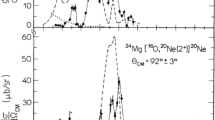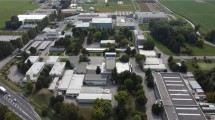Abstract
Some results of investigations into a new nuclear-physics field associated with the production of radioactive nuclear beams and physical studies with these beams are presented. The most recent results obtained by studying the structure of nuclei and reaction mechanisms with radioactive nuclear beams are surveyed. Data obtained in Dubna at the DRIBs accelerator complex are presented along with allied results from other research centers. In this connection, existing experimental data on light loosely bound exotic nuclei are discussed. The parameters of DRIBs3, which is a new accelerator complex, are presented, and the physics research program that will be implemented with the aid of new setups, including a high-resolution magnetic analyzer (MAVR) and a 4π neutron detector (TETRA), is described. A collaboration in the realms of employing radioactive nuclear beams at the DRIBs complex together with other accelerator complexes [SPIRAL2 (France), RIKEN (Japan), FAIR (Germany), and RIBF (CIIIA)] on the basis of employing new highly efficient experimental facilities has already led to the discovery of new phenomena in nuclear physics and will make it possible to study in the future new regions of nuclear matter in extreme states.
Similar content being viewed by others
References
W. T. Diamond, Nucl. Instrum.Methods Phys. Res. A 432, 471 (1999).
Yu. Ts. Oganessian et al., Preprint JINR No. E7-2000-83 (Joint Inst. Nucl. Res., Dubna, 2000).
Yu. E. Penionzhkevich, Phys. At. Nucl. 71, 1127 (2008).
N. I. Tarantin, Phys. Part. Nucl. 26, 440 (1995).
L. Gaudefroy, W. Mittig, N. A. Orr, et al., Phys. Rev. Lett. 109, 202503 (2012).
T. Motobayashi et al., Phys. Lett. B 346, 9 (1995).
D. Sohler et al., Phys. Rev. C 66, 054302 (2002).
Yu. S. Lyutostanskii et al., Izv. Akad. Nauk SSSR, Ser. Fiz. 53, 29 (1989).
C. Thibault et al., Phys. Rev. C 12, 644 (1975).
F. Sarazin et al., Phys. Rev. Lett. 84, 5062 (2000).
Yu. E. Penionzhkevich, Phys. At. Nucl 77, 75 (2014).
F. M. Marqués et al., Phys. Lett. B 381, 4407 (1996).
I. Tanihata et al., Prog. Part. Nucl. Phys. 35, 505 (1995).
O. M. Knyaz’kov et al., Phys. At. Nucl 59, 1138 (1996).
A. Goldhaber, Phys. Lett. B 53, 306 (1974).
R. Anne et al., Phys. Lett. B 250, 19 (1990).
N. Orr et al., Phys. Rev. Lett. 69, 2050 (1992).
R. Kalpakchieva et al., Phys. At. Nucl. 70, 619 (2007).
K. Arai et al., Phys. Rev. C 51, 2488 (1995).
N. K. Skobelev et al., Z. Phys. A 341, 315 (1992).
Yu. Ts. Oganessian, V. I. Zagrebaev, and J. S. Vaagen, Phys. Rev. Lett. 82, 4996 (1999).
A. S. Fomichev et al., Z. Phys. A 351, 129 (1995).
M. S. Hussein et al., Phys. Rev. C 46, 377 (1992).
J. J. Kolata et al., Phys. Rev. Lett. 81, 4580 (1998).
A. Lemasson et al., Phys. Rev. Lett. 103, 232701 (2009).
Yu. E. Penionzhkevich, Int. J. Mod. Phys. E 20, 938 (2011).
N. K. Skobelev, Phys. At. Nucl. 77(11) (2014, in press).
Yu. A. Muzychka and B. I. Pustylnik, in Proceedings of the International School-Seminar on Heavy-Ion Physics, Alushta, 1983, Preprint JINR No. D7-83-644 (Joint Inst. Nucl. Res., Dubna, 1983), p. 420.
V. I. Zagrebaev, Phys. Rev. C 67, 061601(R) (2003).
Yu. E. Penionzhkevich et al., Phys. Rev. Lett. 96, 162701 (2006).
S.M. Lukyanov et al., Phys. Lett. B 670, 321 (2009).
T. Kobayashi et al., Nucl. Phys. A 538, 343 (1992).
A. A. Korsheninnikov et al., Phys. Rev. C 53, R537 (1996).
Author information
Authors and Affiliations
Corresponding author
Additional information
Original Russian Text © Yu.E. Penionzhkevich, 2014, published in Yadernaya Fizika, 2014, Vol. 77, No. 11, pp. 1465–1479.
Rights and permissions
About this article
Cite this article
Penionzhkevich, Y.E. Radioactive nuclear beams: Present and future. Phys. Atom. Nuclei 77, 1400–1414 (2014). https://doi.org/10.1134/S1063778814110052
Received:
Published:
Issue Date:
DOI: https://doi.org/10.1134/S1063778814110052




